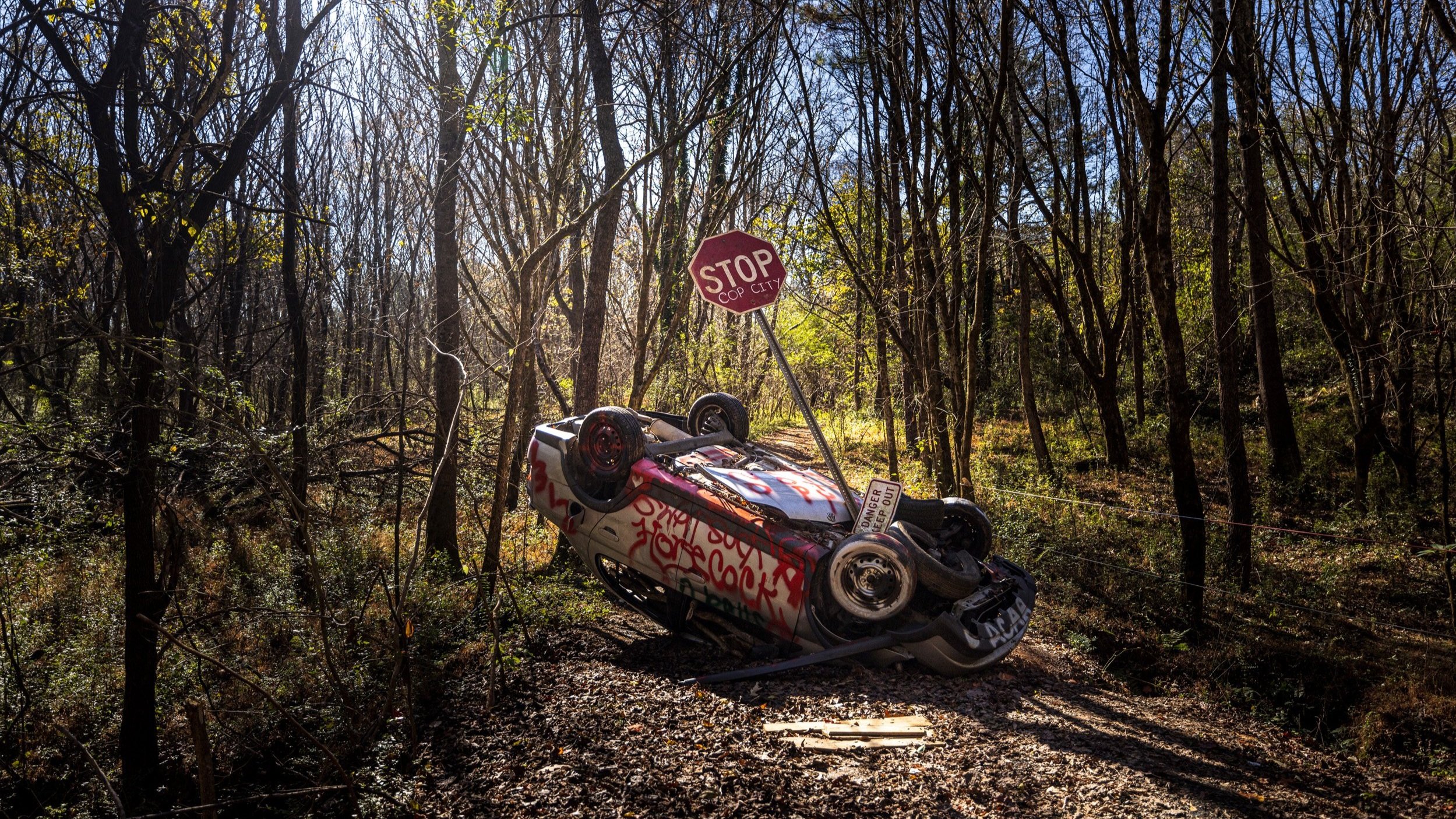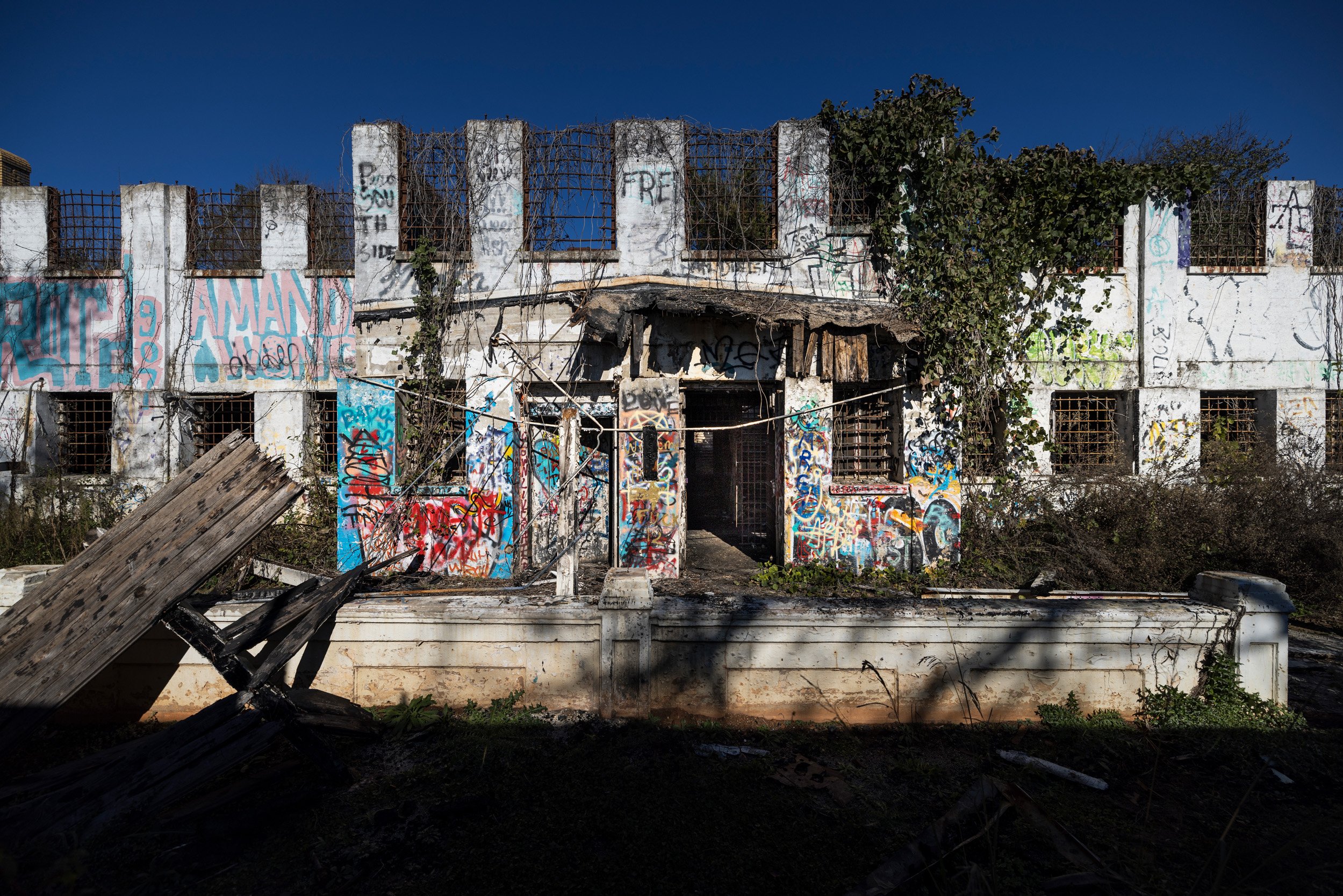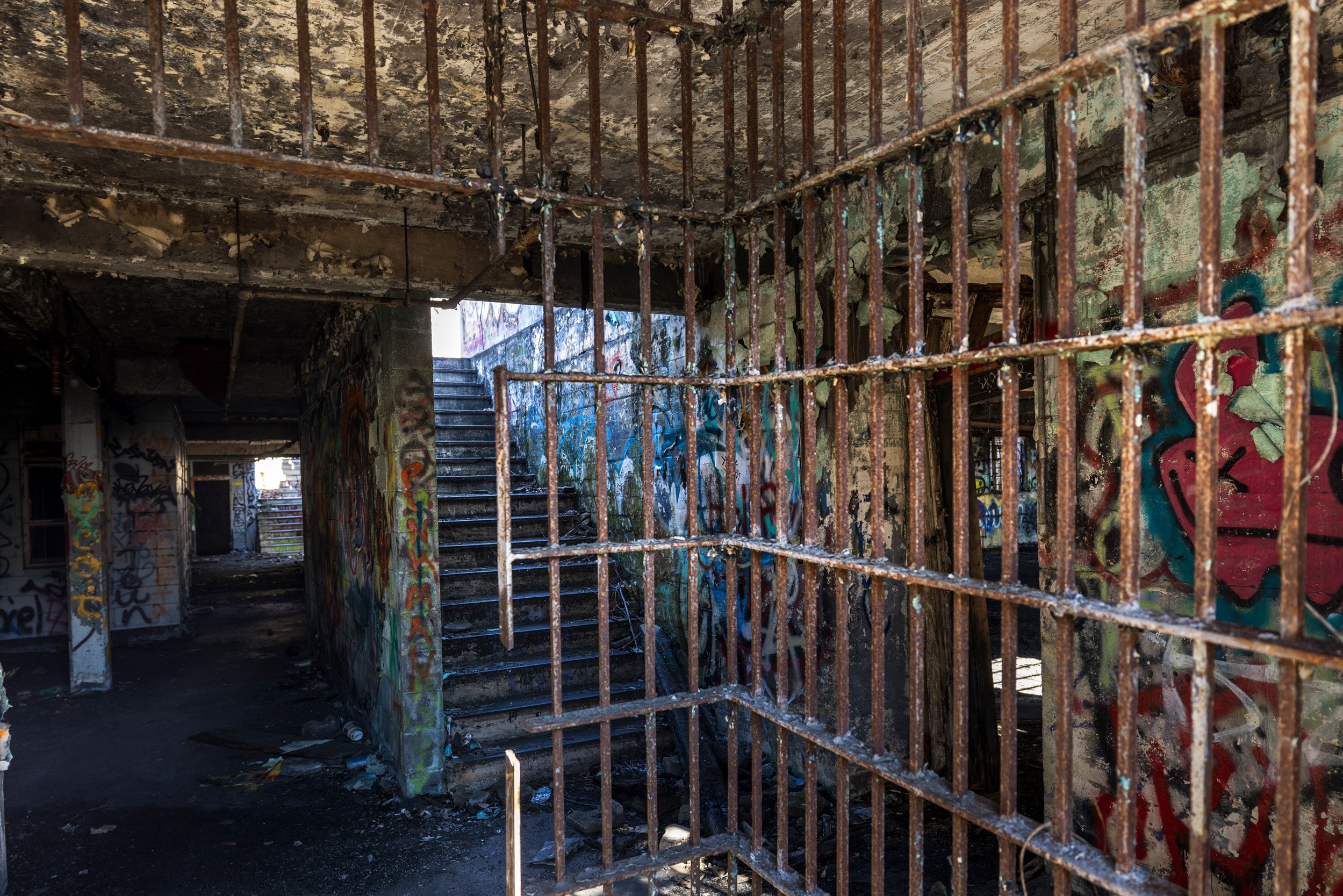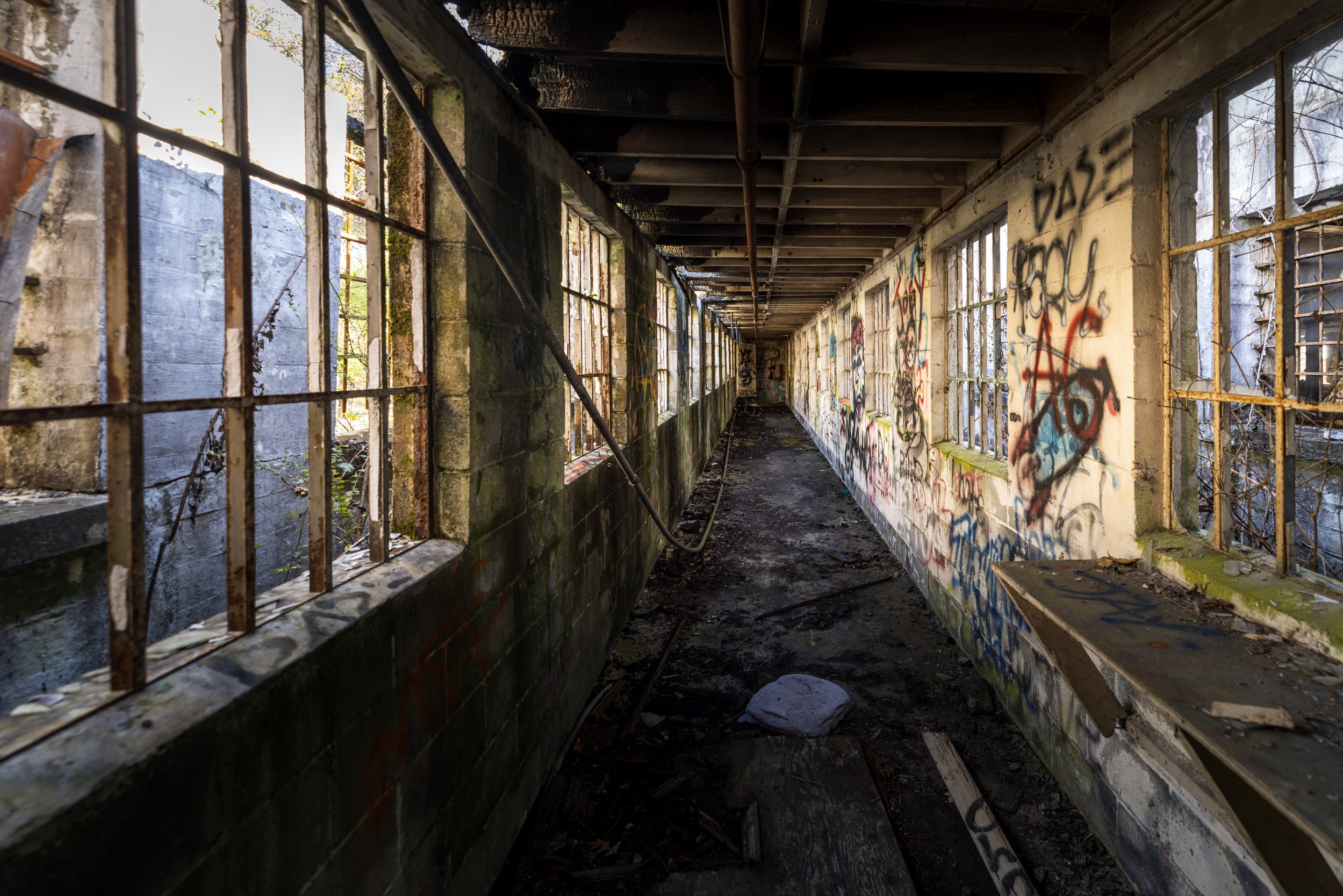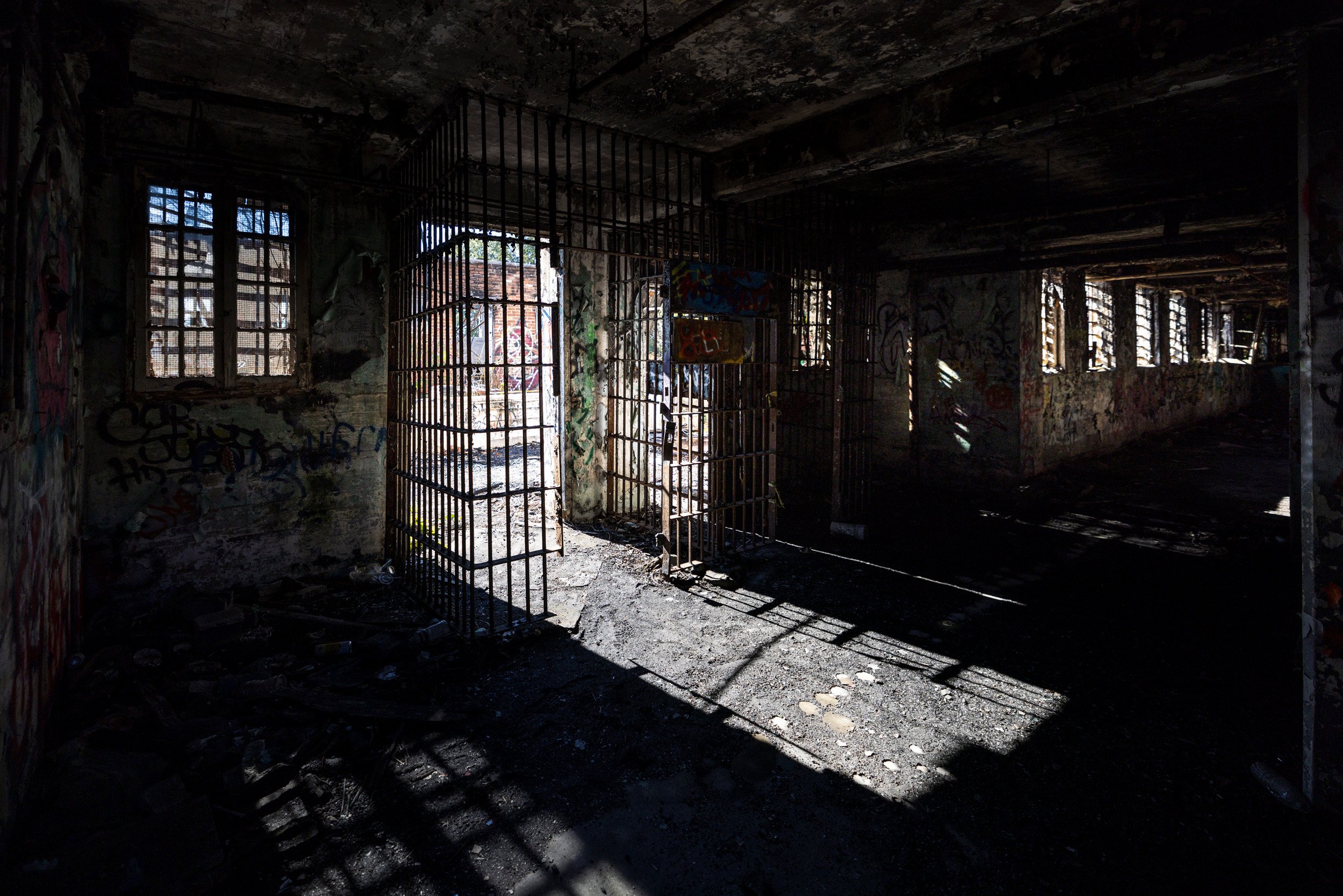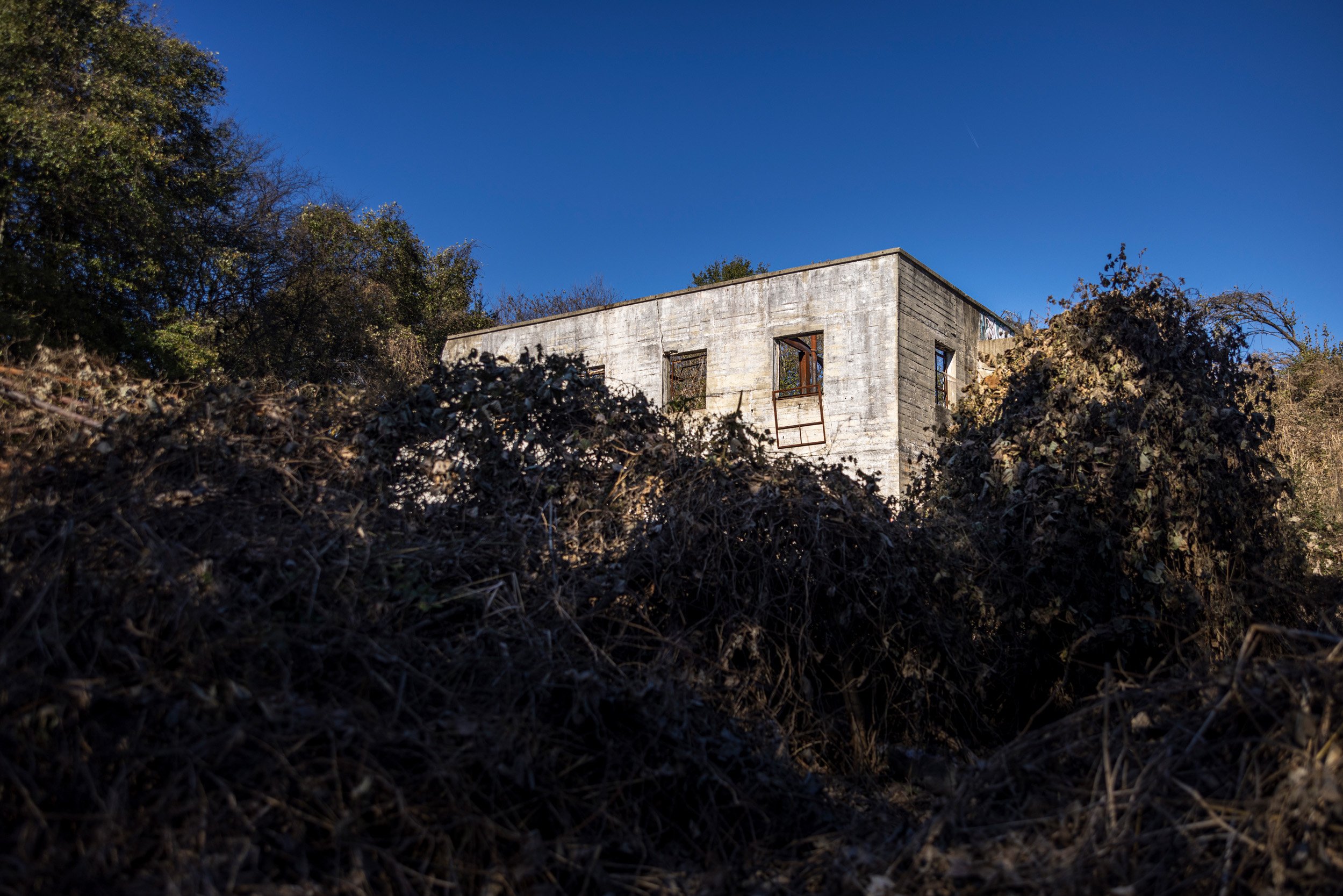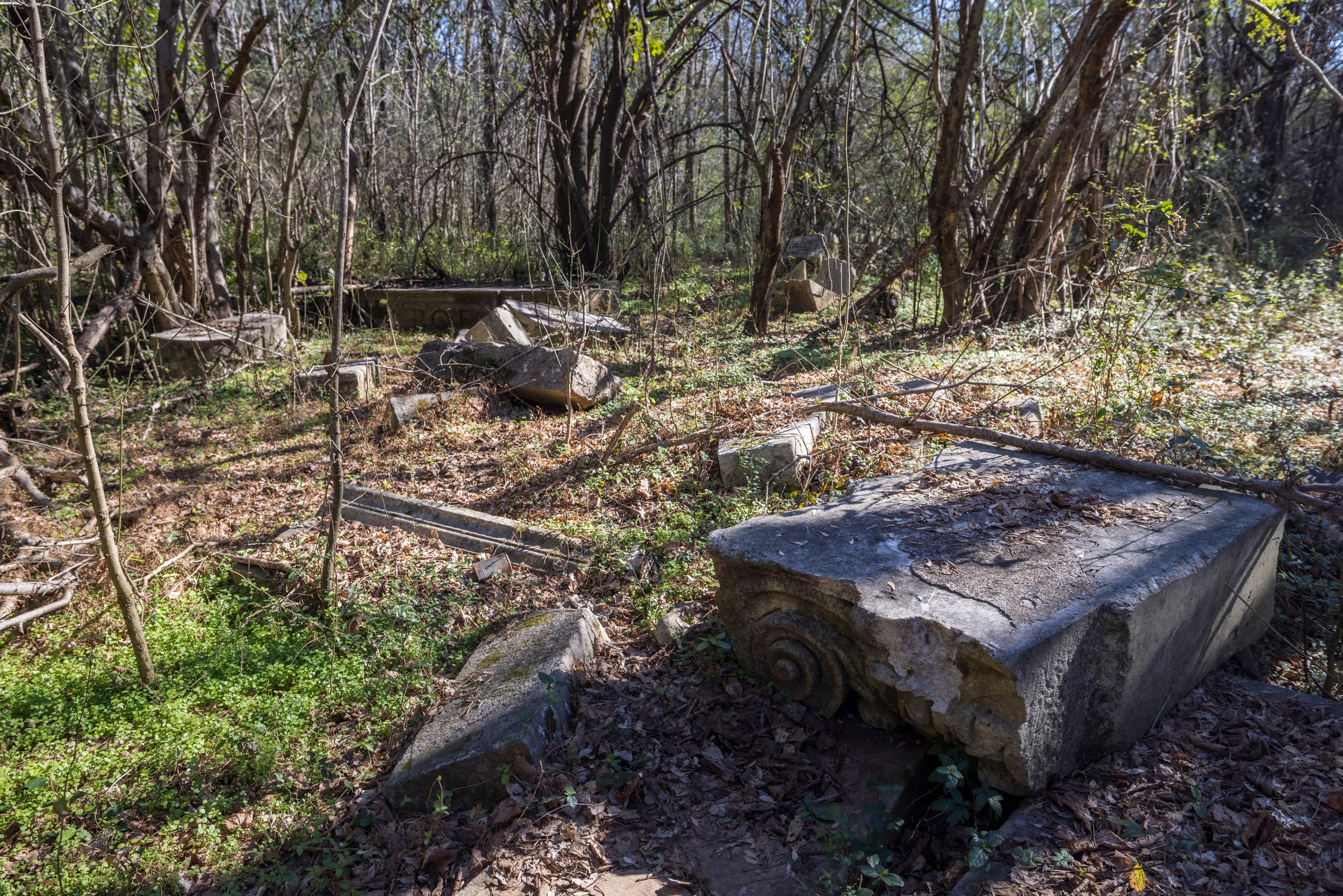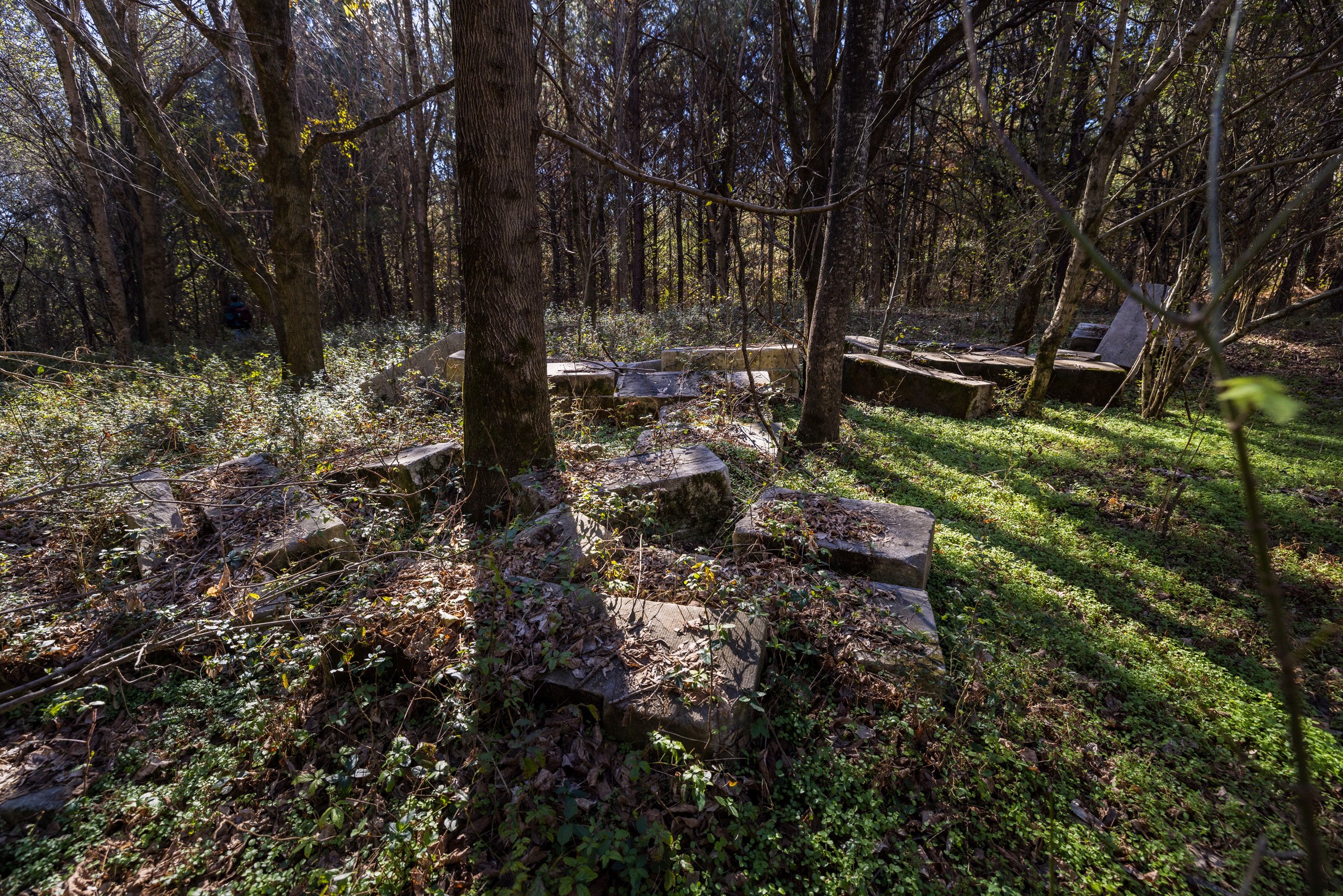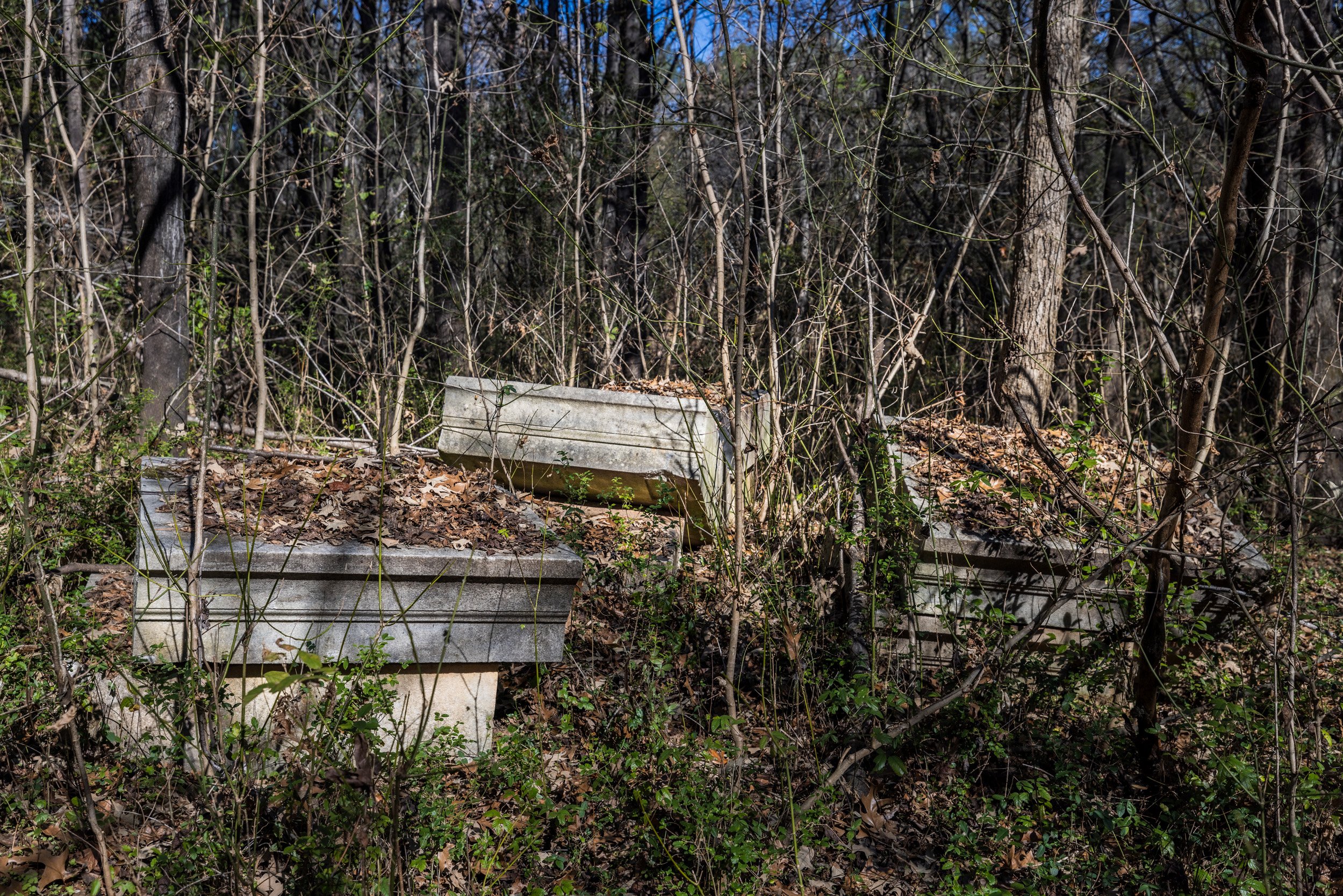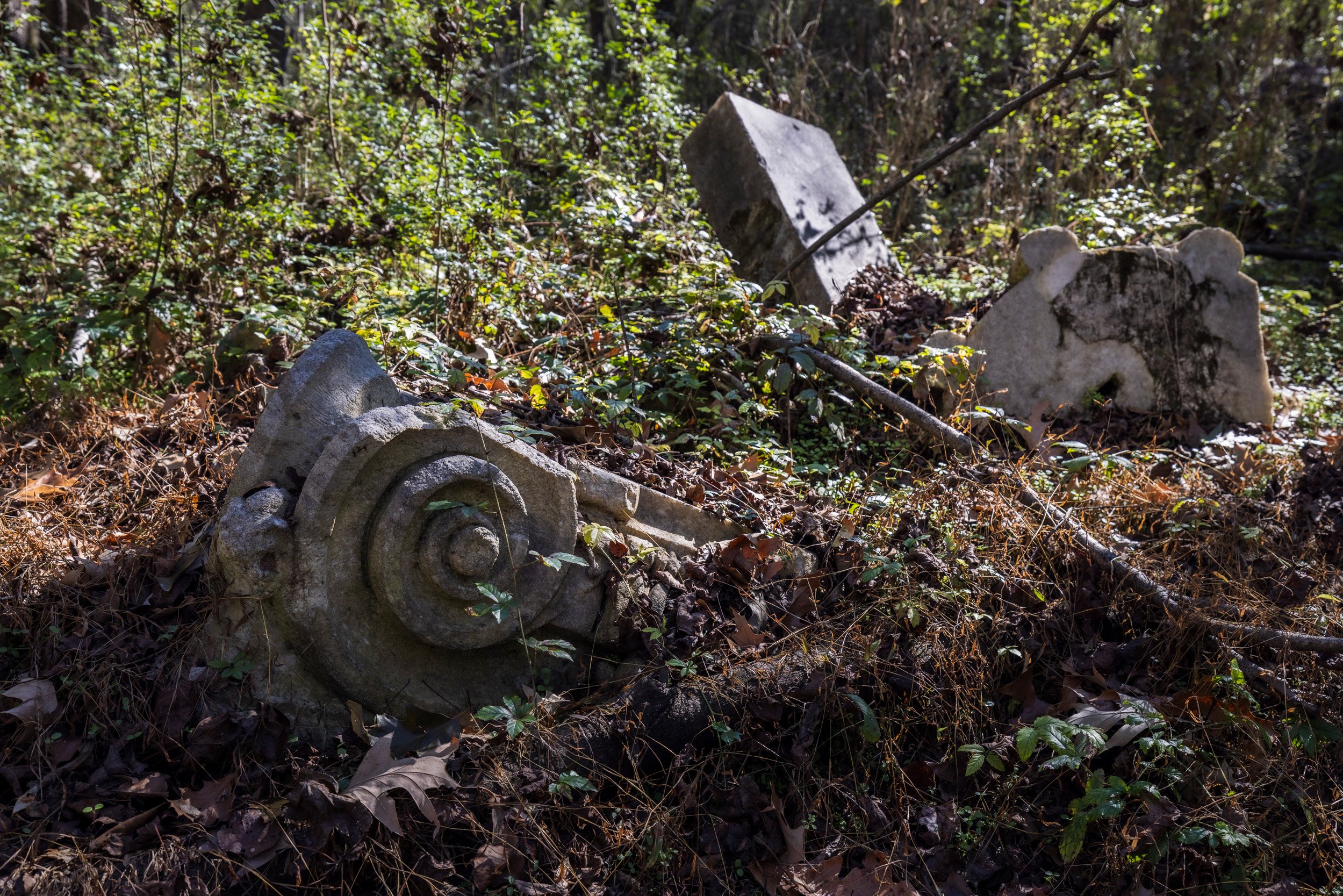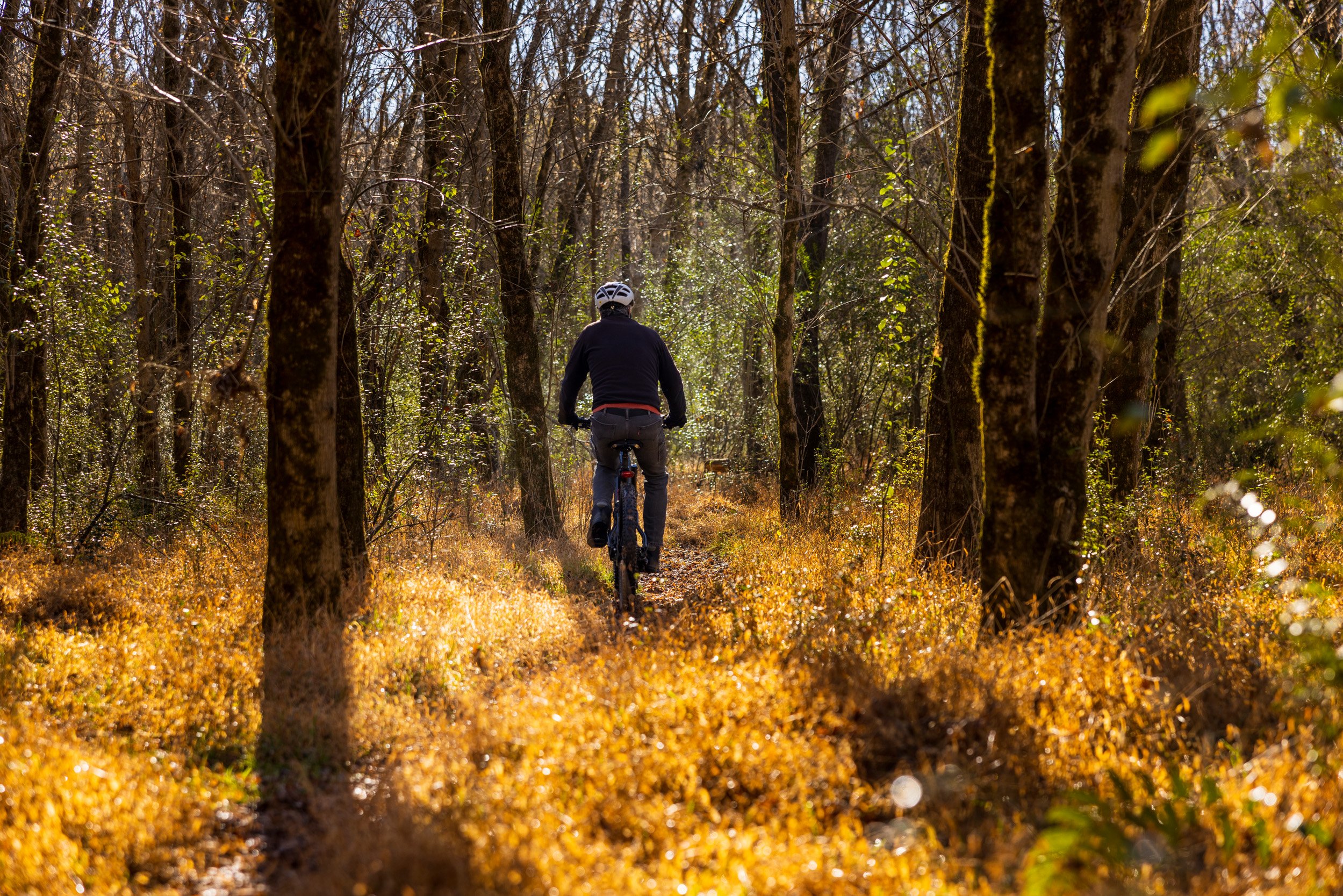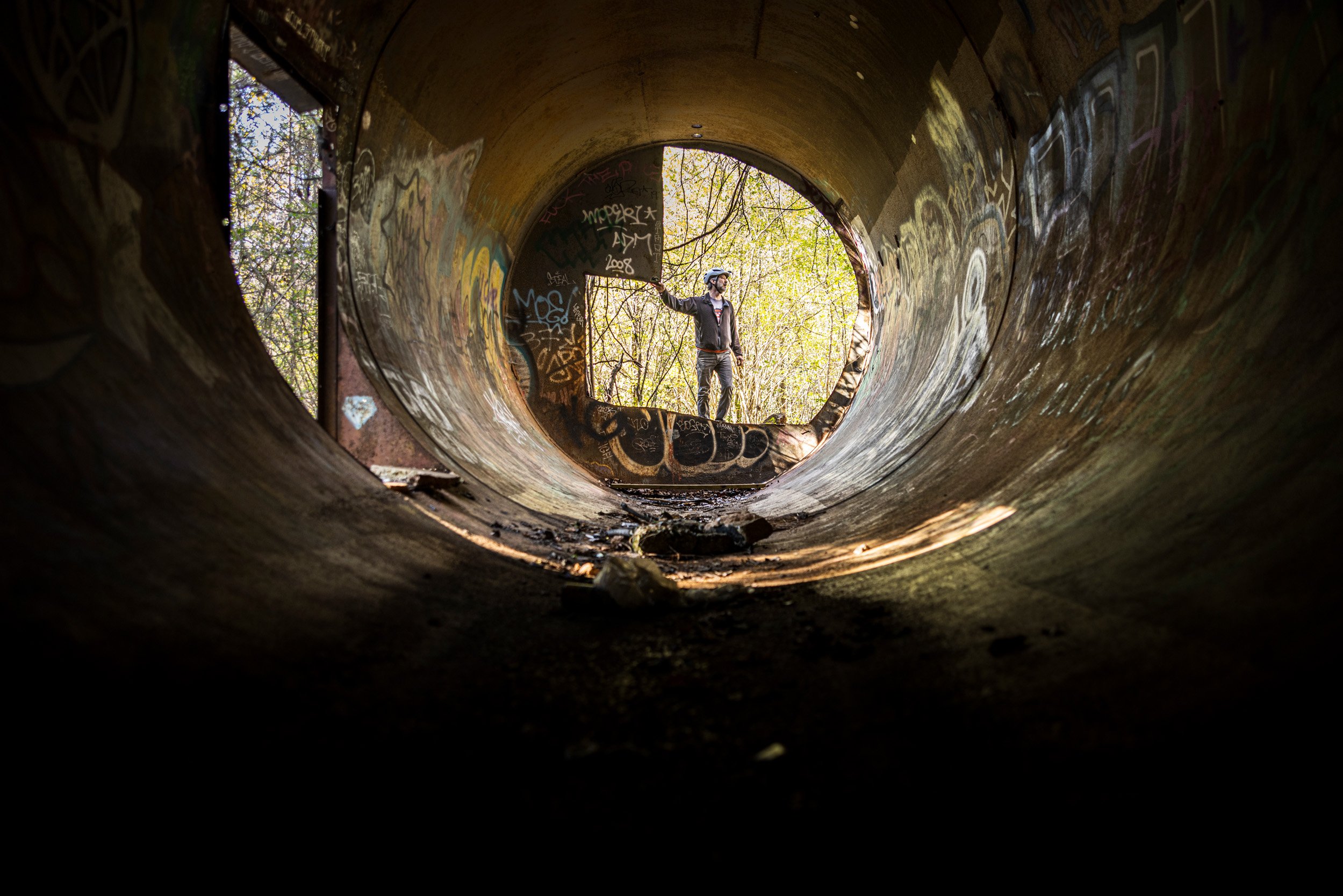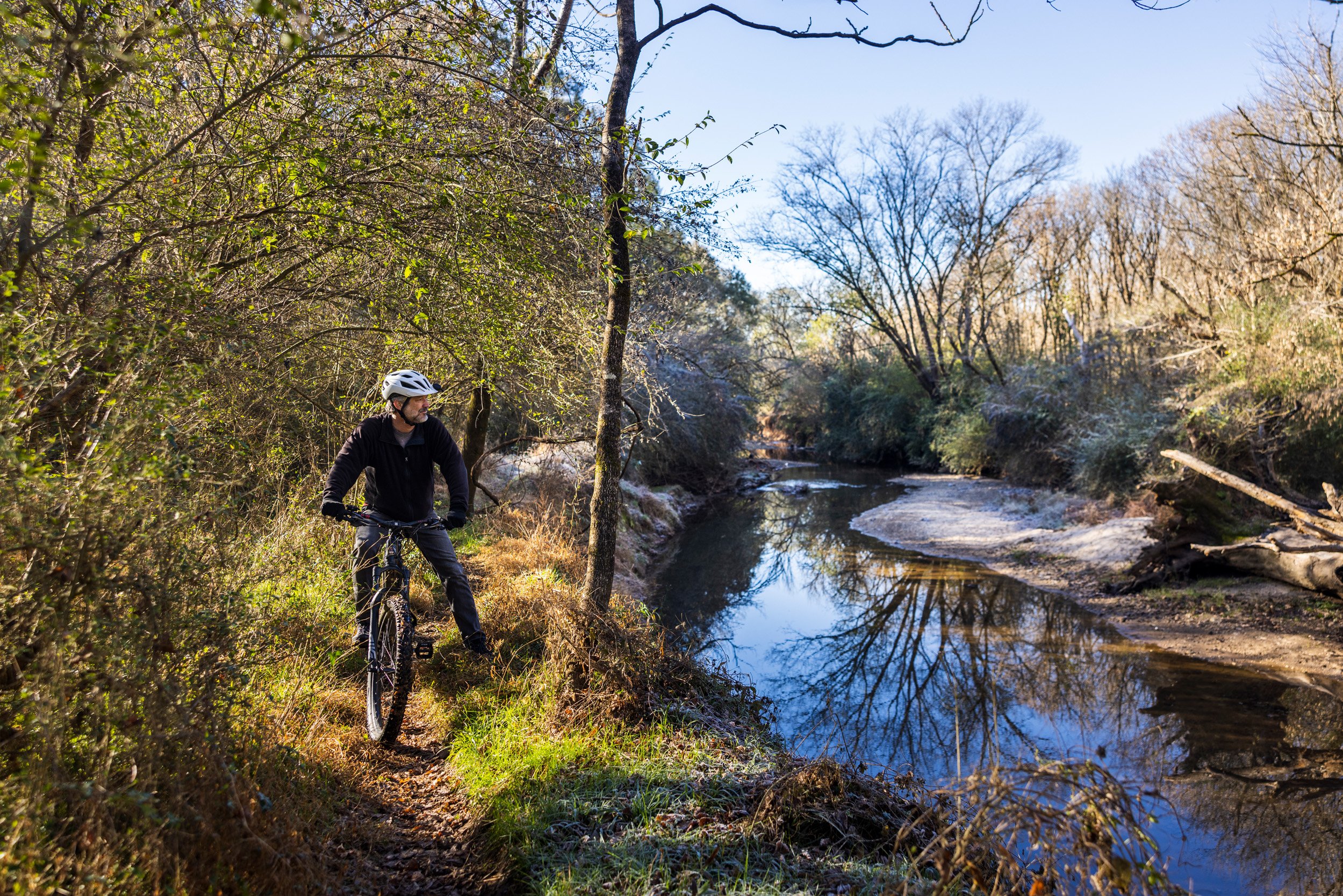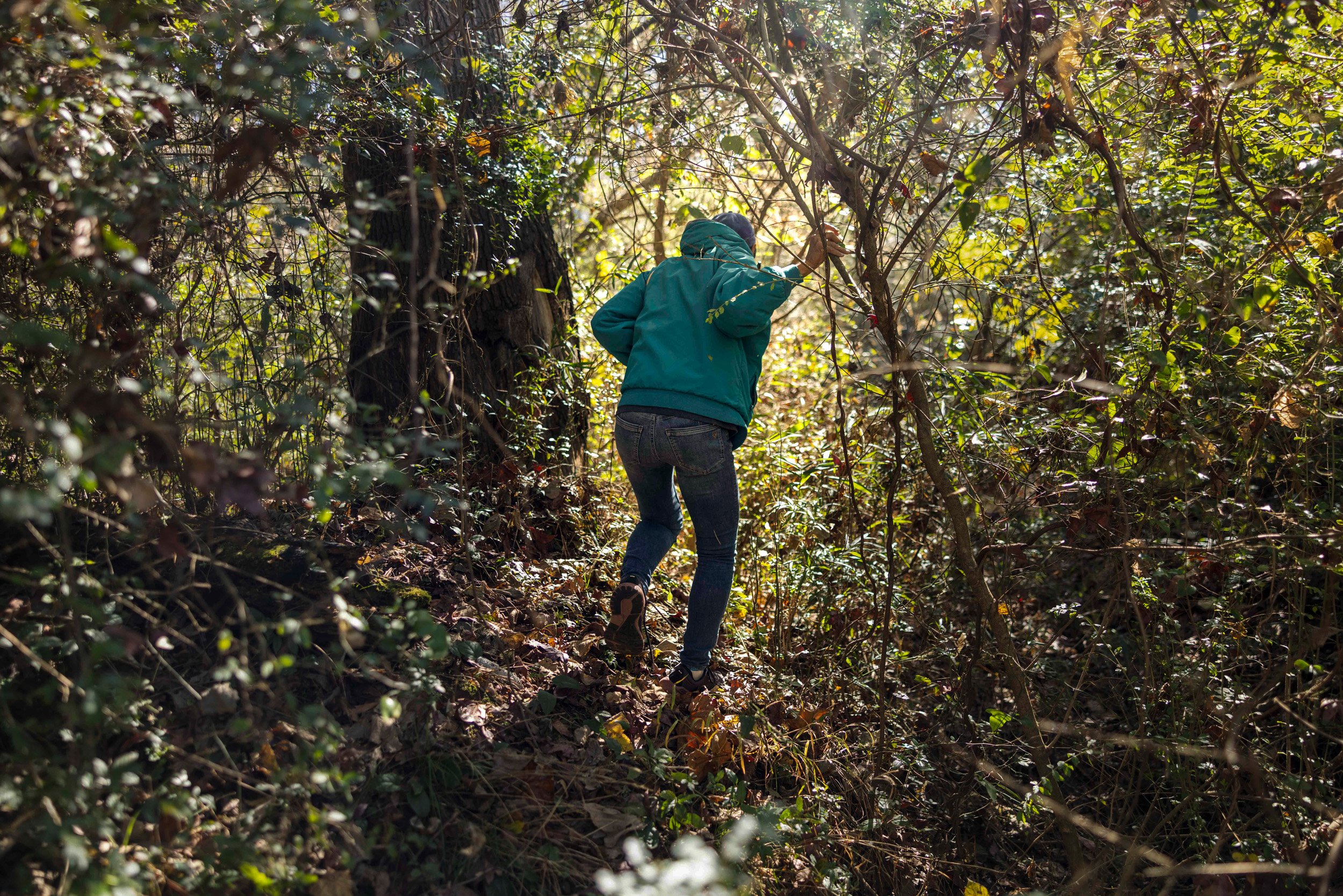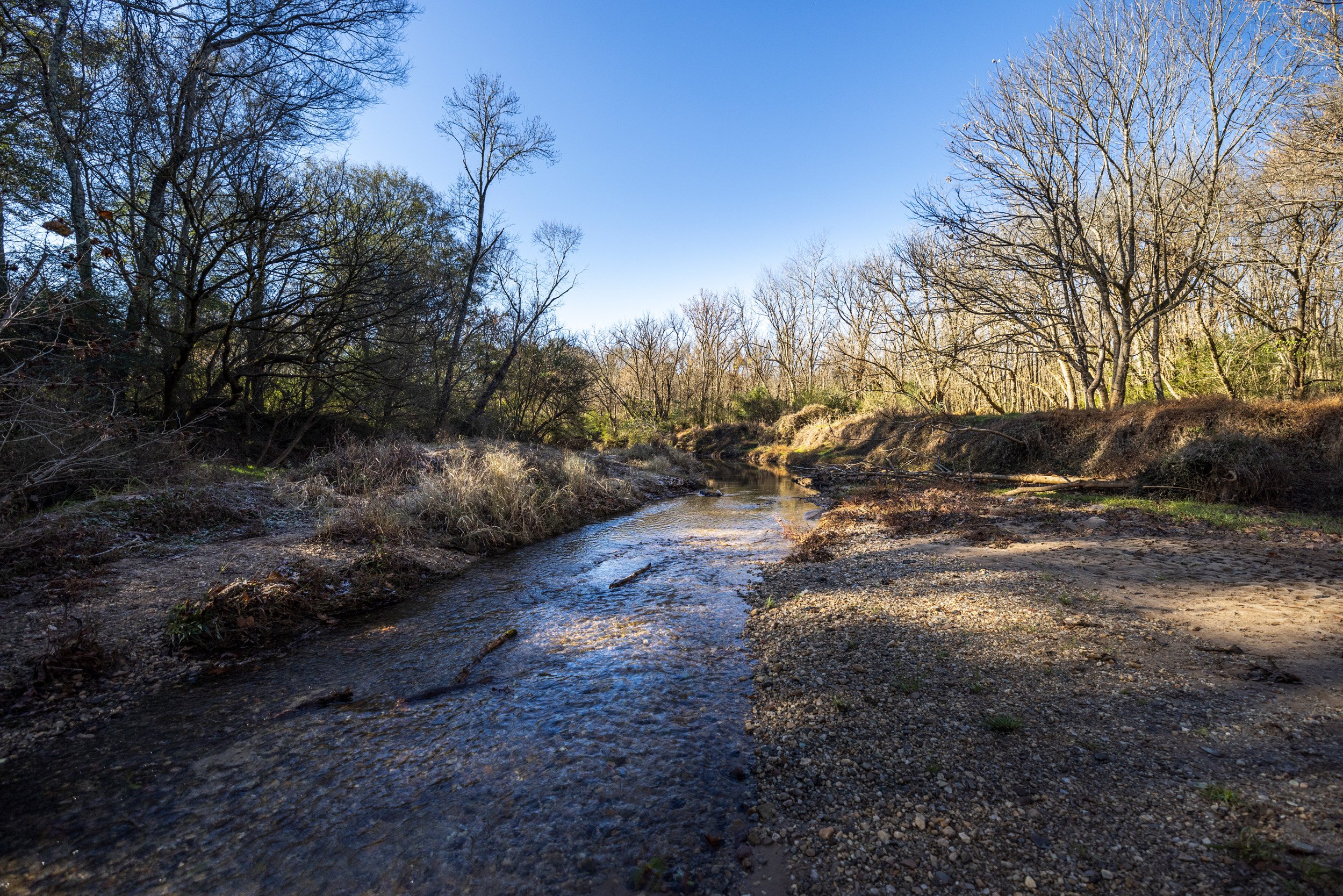A band of activists has turned a fight over a forest in southeast Atlanta into a wide-ranging, no-holds-barred battle over the climate crisis, environmental justice, white supremacy, the future of policing, and the very nature of protest movements. But will it work?
Words by DAVID PEISNER | Photos by FERNANDO DECILLIS
December 13, 2022
On January 9, 1975, a 59-year-old truck driver named Leroy Horton was arrested for public drunkenness and sentenced to 20 days at Atlanta’s prison farm. He arrived at the property, which sat on a sprawling piece of wooded land just outside the city limits, the same day.
For many years, the prison farm had operated as the city’s unofficial drunk tank. Despite the fact most inmates were serving sentences for minor infractions, life there could be punishing and brutal. For decades, prisoners were forced to undertake backbreaking agricultural labor for long hours under deplorable conditions. The farm was habitually overcrowded — in 1941, the prison’s superintendent admitted to housing nine Black prisoners in 12 square feet of space — and unsanitary. Reports of sexual violence by guards weren’t uncommon. Neither were inmate deaths.
Four days after Horton arrived that January, he woke up with a headache and open sores on his body. A nurse determined his hair, body, and clothes were infested with lice. He was given clean clothes and a bottle of Kwell shampoo, then told to shower. Around 10:30 a.m., he took his old clothes to a room where a fellow inmate, Theodore Lee, was instructed to spray Horton’s clothes with a substance called Sulfotep, which the facility used for delousing. After Horton showered, he asked Lee to spray the Sulfotep directly on his back. After some initial reluctance, Lee did.
Sulfotep is the commercial name for the chemical pesticide tetraethyl dithiopyrophosphate. It’s acutely toxic. Swallowing less than 5 mg can be fatal, and the Occupational Safety and Health Administration sets an upper limit for skin exposure of 0.2 mg per cubic meter. The city had acquired it from an exterminating company, but it was only supposed to be dispensed by licensed company personnel. At the prison farm, Sulfotep was distributed from an unlabeled squeeze bottle by inmates.
Within an hour of being sprayed, Horton was shaking and complaining of chest pains. By 2:30 p.m., he was dazed, cold to the touch, unresponsive, and barely breathing. An ambulance brought him to Grady Hospital, where he died three weeks later.
Horton’s death was the second in a week for the prison farm. The previous Wednesday, Larry Lawrence, a 34-year-old Sheetrock installer, was found hanged in his cell. He’d been serving 60 days for violating a city ordinance listed as “creating a turmoil.”
The Public Safety Training Center will be built on land where Atlanta’s prison farm once operated. The land has sat largely abandoned and neglected since the farm closed in the early 1990s.
In April of 2021, then-Atlanta Mayor Keisha Lance Bottoms announced plans for a new training facility for police and firefighters on the land where the prison farm once operated. The property, which is in a predominantly Black, lower-income area, has sat largely abandoned and neglected since the farm closed in the early 1990s. In that time, buildings there have collapsed, decayed, and been reclaimed by nature and enterprising graffiti artists. Previously cleared swaths have reforested themselves.
Not all the neglect has been benign. The land became a dumping ground for businesses and residents, evidence of which remains scattered throughout the property. In places, knotty tree trunks and leafy vines grow up, around, and through disused auto parts, rusting steel drums, and crumbling cinder blocks. Mountains of old tires dot the property. It’s common to find spent ammunition left by the Atlanta Police Department, which uses an area around the forest as a gun and explosives range. There’s more surprising detritus, too. The stately marble façade from the Carnegie Library, Atlanta’s first public library, was discarded in a section of the woods in large stone pieces sometime after it was demolished in 1977. The Atlanta Zoo buried several elephants on the property. More troublingly, some inmates who died at the prison farm are widely believed to be buried in unmarked graves, though none have yet been found.
The city owns the property, but it sits in unincorporated DeKalb County, which created an unusual set of circumstances around the development of the Public Safety Training Center (PSTC), as the new facility would be called. The project, a $90 million public-private partnership, had to be approved by City Council, but because the land lies outside the city limits, nobody living in the neighborhoods immediately surrounding the property had representatives on the council. When the council opened the proposal to public comment, they received more than 17 hours of it — the majority opposing it — then voted to approve the project anyway.
Pieces of the marble façade of Atlanta’s Carnegie Library were discarded in a section of the woods.
The main force behind the PSTC has been the Atlanta Police Foundation, a private nonprofit founded in 2003 to support policing initiatives. The APF’s board includes executives from many of the city’s most prominent corporations — including UPS, Delta, Home Depot, Waffle House, Equifax, and Chick-fil-A — as well as high-profile law firms, contractors, real estate companies, and banks. The initial fundraising push for the center was led by Alex Taylor, CEO of Cox Enterprises, which owns The Atlanta Journal-Constitution. (The paper’s coverage has been criticized for being broadly supportive of the project without consistently disclosing its APF ties.) Blueprints for the facility include a new shooting range, a burn building, a vehicle skills pad, a kennel, a horse barn, and a mock city where police could train for urban warfare. Critics dubbed the development “Cop City.”
The APF referred all inquiries to a spokesperson for the city, who said, via email, “Atlanta has had second-rate facilities or had to rent the facilities of jurisdictions a half-day or more away from the city at odd hours. The Public Safety Training Center will provide Atlanta’s public safety officials with a venue for coordinated training, modern urban firefighting cityscapes, an emergency vehicle operations course, and modular design for classrooms to enable flexible training consistent with the needs of 21st-century public safety agencies.”
Coming on the heels of the nationwide Black Lives Matter protests following the killing of George Floyd by Minneapolis police, and accompanying local protests that were inflamed by the subsequent shooting death of Rayshard Brooks by Atlanta police, the decision to build the training facility on this land looks to be, at the very least, an extraordinary misreading of the room. Amid calls to defund the police, the city was committing at least $90 million — one-third from taxpayers — to its police force, whose morale was reportedly low following the previous year’s protests.
A clearing with power lines bisects the prison farm and the forest surrounding it. Though some of the trees are more than 100 years old, the majority began growing in the latter decades of the 20th century.
Last year, activists began traveling from across the country to occupy the forest on and around the former prison farm property, broadcasting their intent across social media with slogans like “Stop Cop City” and “Defend the Forest.” Construction around the property would involve clearcutting sections of the woods. That loss of the trees is projected to exacerbate the local urban heat island effect — where unshaded pavement and buildings absorb and radiate heat into the surrounding air — worsen flooding, and further pollute two endangered local waterways, Intrenchment Creek, which runs alongside the prison farm, and the South River, which the creek flows into less than 1,000 yards away.
Among the many points of contention for those opposed to the facility is that developers have done only cursory assessments of the project’s environmental impact. “There’s the issue of buried contamination, which we can’t be sure about because the correct investigations have never been done,” said Lily Ponitz, an environmental engineer. “With the type of chemicals that would’ve been used on that prison farm, there’s undoubtedly toxic legacy pesticides, but [the environmental assessments] didn’t look for that.”
One of the chemicals that hasn’t been investigated is the Sulfotep that killed Leroy Horton. The EPA classifies it as an environmental hazard. The National Center for Biotechnology Information warns, “Do NOT let this chemical enter the environment” (emphasis theirs) and recommends that anyone undertaking cleanup wear “complete protective clothing including a self-contained breathing apparatus.”
Ponitz believes the Sulfotep is just the tip of the iceberg regarding the project’s environmental issues, but the city and the APF don’t want to hear about it. She’d been a member of the Community Stakeholder Advisory Committee, a group formed to consult with the project’s developers, but was removed after publicly airing her criticisms. “There was such a façade of this committee being a positive force on the project,” she said. “I was basically saying ‘No, they’re ignoring everything.’”
* * *
For progressive activists, Atlanta’s PSTC represents something of a perfect storm: a single project that catalyzes fears of ecological degradation, state-sponsored violence, police militarization, environmental racism, opaque governance, and the long legacy of white supremacy. In the same way environmental issues are never simply local, the concern is that this training center — which would dwarf those of much larger departments in New York, Los Angeles, and Chicago — will become a nationwide model. As one activist living in the woods told me in August, “The intersection between the climate crisis, growing inequality, and the militarization of cops is emblematic here, but it’s a problem everywhere.”
The land where the PSTC would be built borders another parcel of public land under environmental threat. Across the creek from the prison farm, less than 4 miles from downtown Atlanta, is Intrenchment Creek Park, an approximately 136-acre plot of dense woods, winding trails, and a large airfield for radio-controlled aircraft. In February 2021, DeKalb’s Board of Commissioners approved a deal to swap 40 acres of the park for three smaller plots owned by Blackhall Studios, less than a mile away. Blackhall already owned 850,000 square feet of soundstages, warehouses, and offices spread across more than 100 nearby acres where movies like “Venom” and “Jungle Cruise” were filmed, and planned to build additional soundstages on the swapped park land. As with the PSTC, this giveaway of public land happened without much public input. In response, a contingent of residents and environmental groups filed a lawsuit to cancel the deal, arguing, among other things, that the land the county received in trade wasn’t equitable. The lawsuit is currently working its way through the courts.
A few months after the land swap was approved, Blackhall’s founder, Ryan Millsap, sold the studio to an investment group, which renamed it Shadowbox. Despite the sale, Millsap retained the 40 acres of swapped land, but he hasn’t clarified his plans for it.
Construction of the PSTC would require clearcutting sections of the woods, which would exacerbate the local urban heat island effect, worsen flooding, and pollute two endangered local waterways.
On a hot day in mid-August, I made my way from the parking lot at Intrenchment Creek Park, down a few narrow trails, into the woods. There, several large tarps strung between trees and the ground delineated a makeshift base camp for the protesters living in the forest, a dozen or so of whom were hanging around when I arrived. Several were in an improvised kitchen area, with gas-powered cooking burners, shelves stocked with canned goods, a foot-pump water faucet, and multiple white basins for washing dishes. The rest were sitting in camping chairs around a table — really, two stacked wooden pallets — in an adjoining area, getting ready for their morning meeting.
Protesters out here, who refer to themselves as forest defenders, live in tents, hammocks, or small treehouses called tree-sits, on both sides of Intrenchment Creek. A large “Black Lives Matter” flag was displayed outside the central meeting area, which everyone calls Space Camp. Inside the tarps was a white banner with the slogan “Defend the Forest,” a black flag with an anarchist symbol on it, and a whiteboard with a to-do list on it. A shelving unit in the sitting area contained multitudes: toilet paper, duct tape, medical supplies, a copy of The Communist Manifesto, bolt cutters, bug spray, an ax, a small drill, and a white Brasfield & Gorrie construction helmet. A vase filled with wildflowers sat at the center of the makeshift table, alongside candles, a tobacco pouch, two bongs, a machete, and a portable charger with phones plugged into it.
The community in the forest is in constant flux. Some people stay here for months, some for just a few days, and many leave and then return for additional stints. It’s a decentralized, autonomous movement — so nobody is in charge, and nobody is responsible for anybody else’s actions — but those who’ve been here longer tend to take the lead in setting expectations for the camp’s culture. Green Grass, a short Black man with an earnest, weary bearing and a slight Southern drawl, stood up and started the morning meeting.
“For operational security reasons, most people here don’t like to share their real names, where they’re from, or how long they’ve been here,” he told the group, which included several recent arrivals. The movement, while essentially nonviolent, has done considerable property damage since it began more than a year ago. Construction vehicles have repeatedly been torched. Utility and security trucks have been assailed with rocks and had their tires slashed. Homes and offices of contractors have been vandalized. At one point, a small Molotov cocktail was thrown in the vicinity of the police. In November, some activists destroyed cameras and felled a few small trees in order to take out the power line that services the APD’s firing range. At the very least, anyone who crosses the creek onto the prison farm property is trespassing. Police raids into the forest are common, several forest defenders have already been arrested, and the movement is under investigation by multiple federal and state law enforcement agencies. As such, most of the forest defenders are very wary of outsiders.
Forest defenders have set up a makeshift base camp where members can meet and prepare food in an improvised kitchen.
As the meeting began, each person shared their forest name, their pronouns, how they were feeling, and the tasks they were working on that day. One person had plans to dig a trench. Another was trying to rebuild a recently destroyed bridge. Several planned to work on expanding the kitchen. An activist who goes by Walmart would be keeping watch on who entered the forest and invited others to join her.
Green Grass laid down basic community norms. “No nudity in the parking lot,” he said. “The crew here is sex-positive. They like to run around naked. That’s fine within the camp, but not such a good idea in areas where people and families could be walking around. We want to be good neighbors. Also, we practice a culture of consent. No means no. If it’s not an enthusiastic ‘yes,’ it’s a ‘hell, no!’”
Green Grass also reminded everyone of the forest’s brutal history. Before it was a prison farm, it was a slave plantation and before that, it was home to the Muscogee tribe, who were violently expelled in the 1820s and 1830s. As an acknowledgment, they call the land by its Muscogee name, the Weelaunee Forest.
A few days earlier, I’d asked Green Grass why he came to the forest. “I’m a survivor of police brutality,” he said evenly. “I wouldn’t want anyone else to experience that. I’m also a person who loves nature and trees. If we continue on this path, future generations won’t have all the trees, and future generations will get murdered by police.”
The forest here is not a virgin, old-growth forest. Although there are trees among the 500-plus acres on both sides of Intrenchment Creek that are more than 100 years old, most only sprouted to life as the prison farm began to fade from view in the latter decades of the 20th century. What has grown in these woods, though, is thick and surprisingly wild. Closer to the parking lot, around a spot the forest defenders call The Living Room, tall conifers create a high, cool, shady canopy and a sparse forest floor carpeted with dry, reddish-brown needles. Hike toward the creek and the brush grows heavier, the soil damper. Walking a trail one morning, I nearly stepped on a small copperhead. During these summer months, parts of the forest are swampy and overgrown with thorny vines. Box turtles occasionally poke their heads from the creek, and frogs dive quickly from the surface into shallow water when approached. Hulking black vultures perch on power lines in a clearing that bisects the prison farm. White-tailed deer are abundant and disconcertingly unbothered by the sound of gunfire that often echoes from the APD shooting range.
White-tailed deer are abundant in the forest.
The community built in this forest is a hybrid forged, in part, from knowledge gained from previous encampments. Some forest defenders are veterans of pipeline protests or the Occupy movement, but many have simply absorbed their lessons, reading about them, watching YouTube videos, listening to podcasts, or attending information sessions. The community’s leaderless nature, its focus on direct action, as well as its anarchist and Marxist leanings, are, in part, an inheritance from the environmental activist group Earth First!
“Within the movement, there’s this constant struggle to avoid concentration of power, to disseminate decision-making,” a forest defender who goes by Tortuguita told me. “It’s harder to do anything because people are accustomed to following orders and having strict hierarchies. It gets tricky when you need to do something quickly, but everything kind of works out.”
For some here, the idea that a community can function without leaders or formal structures is a significant draw. “The immediate goal is stopping Cop City and protecting the forest,” said Sabbo, a trans woman who was wearing an Industrial Workers of the World baseball hat when we first met. “But in a larger sense, by being here, we’re proving you don’t need a lot of things in society we take for granted, like somebody maintaining order or some figurehead directing things.”
The decision to organize the movement this way is strategic. If nobody’s in charge, nobody can negotiate away demands. In fact, nobody can negotiate at all. “There’s no way to co-opt it,” said Tortuguita. It’s unreasonable by design.
On one level, the forest defenders’ strategy is simple: By occupying this land, they’re making themselves an immovable obstacle to any construction project. But there are layers to their strategy. The movement and its allies pressure companies not to work on these projects. This can mean inundating the offices of, say, Brasfield & Gorrie, the general contractor for the PSTC, with phone calls imploring them to drop the contract. Activists have also visited contractors’ offices to disrupt meetings, marched through other job sites, and demonstrated outside company executives’ homes. Within the forest, barricades are built to slow construction. Equipment is sabotaged. When all that fails, forest defenders put their bodies on the line, climbing into trees to prevent them from being felled.
Land defense like this is unusual in such an urban locale. It puts the community of protesters in closer proximity to resources, but also in closer proximity to homes and businesses. Neighbors who might be against building a police training facility in their backyard may not be enthusiastic about having fiery, anti-capitalist activists living there, either. Being a disruptive presence and a good neighbor can be tricky.
“It’s incredibly important to continue having popular support,” said Tortuguita, who uses they/them pronouns. “Cop City is incredibly unpopular already. We’re very popular. We’re cool.” They laughed as they said that last bit, but, without a doubt, the movement has succeeded in painting the forest defenders as a scrappy, idealistic David battling a heartless, moneyed Goliath. “We get a lot of support from people who live here, and that’s important because we win through nonviolence. We’re not going to beat them at violence. But we can beat them in public opinion, in the courts even.”
The forest defenders have drawn outsize attention to this plot of land — #stopcopcity and #defendtheweelauneeforest have become viral hashtags on progressive social media. The movement has toured the country, spreading the gospel at coffee shops, co-ops, indie record stores, skate parks, squats, art galleries, and bookstores. Graffiti and direct action supporting the movement have emerged as far afield as Omaha, Nebraska; Oakland, California; New York City; and Bogota, Colombia.
Not everyone is enamored. Critics note that forest defenders are coming mostly from out of town to dictate to locals what to do with their land. Some feel their tactics are beyond the pale.
“They’re terrorists,” said Jay Scott, an urban planner and landscape architect who has worked closely with Millsap and first proposed the Intrenchment Creek land swap. “They’ve done millions of dollars of damage to equipment. They’ve followed people to their homes and threatened them. Talking about them being environmental protesters is giving them a benefit of the doubt they don’t deserve.” Scott later called me back to make sure I understood he considers himself a “liberal and an environmentalist.”
The politics of this struggle don’t follow the usual contours. This isn’t Republicans versus Democrats. In Scott’s view, this is “left versus far left,” with the debate being dominated by the radical fringe of forest defenders.
Protesters cycle in and out of the forest, and the movement sticks to an autonomous framework.
Over more than a dozen visits between late July and early December, I met more than 35 forest defenders. A snapshot of the community emerged. Nearly everyone I met was in their 20s or early 30s, and although a few were from Georgia, most weren’t. The forest defenders are largely white, and by rough estimate, nearly half identified as LGBTQ. As a trans woman on her second stint in the woods explained, “Trans and queer people are overrepresented in this space, but also in protest movements in general. They’re already marginalized and have trouble operating in other spaces, so they’re more likely to come to a space like this. Also, trans people helped build this community, so of course they’re going to make it more inviting for other trans people.”
Most of the forest defenders are well-educated. One afternoon, I walked into Space Camp to hear Sabbo delivering what felt like a graduate-level seminar in political philosophy, freely quoting from Albert Camus’ The Myth of Sisyphus. Conversations comfortably lurched from literature to science to the best strategies for dumpster-diving at Whole Foods. Throughout the months I visited, the camp’s Marxists and anarchists were in low-grade rivalry. One day, I watched Tortuguita fish the paperback copy of The Communist Manifesto from an unlit fire pit in mock horror. “Don’t burn The Communist Manifesto!” they exclaimed. “I mean, Marx isn’t perfect, but he’s OK.”
Day-to-day struggles out here are more practical than political. The water in Intrenchment Creek is too polluted to drink, so the community must haul it in in jugs. Ditto for food, though a forest defender named Fruit Bat has been planting vegetable plots in the hope of becoming more self-sufficient. When it rains, keeping everything dry is tough. Mold becomes a problem. “We’re out here trying to be one with nature, but the mold is also nature and trying to decompose our belongings,” Fruit Bat said.
On the park side of Intrenchment Creek, the vibe is often more summer camp than protest camp. People wander the woods, they meditate, they read, they work on projects. Activists can often be found at Space Camp smoking weed and drinking coffee or another brownish liquid that’s a mixture of water and kratom, an herbal substance one forest defender described as “light codeine.”
Cross the creek to the prison farm property and the vibe changes considerably. There, forest defenders hide from view, wearing masks and camouflage. The threat of SWAT raids creates constant, base-level anxiety.
Despite their communal dinners and parties, a definite siege mentality pervades the camp. The emphasis on operational security breeds paranoia. Outsiders aren’t trusted. Every drone buzzing overhead is presumed to be spying on behalf of law enforcement. The forces arrayed against the movement — police, local media, politicians, construction contractors, Ryan Millsap — are often viewed as part of a monolithic oppressor. But ultimately, even this sense of siege has an upside. As one forest defender put it, “It’s super-stressful, but it builds a narrative people can coalesce around. Having some kind of confrontation, having a shared enemy, can build movements.”
The water in Intrenchment Creek is too polluted to drink, so forest defenders must bring it in in jugs.
The fight against the PSTC is pretty straightforward. There’s a definitive plan to build a facility to train a militarized police force on public land that’s been a venue for the suffering of marginalized communities for centuries. What the forest defenders and their allies are battling in Intrenchment Creek Park is more muddled.
The forest defenders have continually railed against the prospect of a film studio being built on the 40 acres of park property, frequently pairing the slogan “No Hollywood Dystopia” with calls to “Stop Cop City.” But when Millsap sold Blackhall, a noncompete clause in the contract precluded his using the swapped land for film studios. Since then, he’s said little publicly to clarify his intentions. When I reached out to him via email, he responded, “I may only be able to offer limited comments due to the ongoing spurious litigation being used as a weapon by the same groups trespassing on my land.” As it turned out, his comments were limited to that single email, as he didn’t respond to repeated attempts to interview him. (It’s worth noting that none of the forest defenders are party to the lawsuit Millsap referred to in his email.)
Nonetheless, it’s not hard to sympathize with Millsap’s position. He’s a businessman who made a deal with DeKalb County. While anger at the deal may have been inevitable because it was done without real transparency, the more rightful target would be the public officials — in particular, the county’s CEO, Michael Thurmond — who cut that deal on behalf of their constituents. Furthermore, it’s hard to imagine the swap would’ve drawn nearly as much scrutiny had the land not been adjacent to where the PSTC is slated to be built.
This past July, despite the pending lawsuit, Millsap and Blackhall Real Estate Phase II, LLC, had barricades installed to block the Intrenchment Creek parking lot and had signs posted near a paved public trail that read “Park Closed — No Trespassing” and “Private Property.” A few days later, the forest defenders had pushed the barricades aside, removed the signs, and “reopened” the park. Days later, a Dodge Ram 5500 pickup registered to Millsap towed an excavator on a flatbed trailer into the parking area, accompanied by four DeKalb County police officers.
Millsap told a local TV news station that he’d sent workers out to clear land. Several forest defenders blocked the excavator from entering the park. The excavator’s operator struck its mechanical arm into the roof of a gazebo while people were inside. Masked activists then emerged from the forest, hurling rocks and cans of sparkling water, forcing the excavator, the police, and the workers to retreat, leaving Millsap’s pickup behind in the parking lot. Forest defenders busted the truck’s windows, yanked off its doors, and set it ablaze. As of early December, the burnt-out husk of the pickup and its trailer were still there — equal parts war booty, tourist attraction, and art installation — littered with graffiti that reads, among other things, “Our woods … Not Hollywood’s,” “No Forest, No Peace” and “Fuck around and find out Ryan.”
The burned-out husk of a truck registered to Ryan Millsap sits in the parking lot of Intrenchment Creek Park after a group of forest defenders stopped him from clearing the land in July.
Atlanta’s favorite story about itself is that it’s “the city too busy to hate.” The phrase, which emerged in the late 1950s and early 1960s, is often invoked to explain how the city became a cradle of the Civil Rights Movement, but it’s code for a darker truth: Money trumps everything here. Sure, that’s true everywhere, I suppose, but few places stamp it on their tourist brochure like a badge of honor. Nothing stands in the way of economic progress here. Property developers run this city.
In the 1990s, the city bulldozed public housing to build infrastructure to host the Olympics, displacing 30,000 low-income residents. The area around the housing projects later became high-end, mixed-use developments. Parts of the historic Black neighborhood of Summerhill were demolished to build the Olympic stadium; for the Georgia Dome, later demolished to make way for Mercedes-Benz Stadium, it was the Black enclave of Lightning.
In 1999, a Georgia Tech architecture and city planning grad student named Ryan Gravel wrote a master’s thesis that proposed turning a 22-mile loop of disused railroad tracks into a ring of public transit and greenspace. His thesis became an object of public fascination, then blossomed into reality as the Atlanta BeltLine. The BeltLine has transformed sections of the city into walkable retail, restaurant, and living space, but Gravel’s vision for light rail and affordable housing has been sidelined. The BeltLine instead has become a real estate bonanza, replacing low-income neighborhoods with rows of pricey restaurants and multimillion-dollar townhomes. This is, to cop another famous local slogan, “the Atlanta way.”
Gravel resigned from the BeltLine Partnership in 2016. The following year, he was the lead author on a document called the Atlanta City Design, which laid out a path for sustainable, equitable growth in and around the city. In the City Design, which the City Council formally adopted in 2017, Gravel earmarked 3,500 acres around south Atlanta as future greenspace, later labeled the South River Forest. The acreage would include nature preserves and parks, including Intrenchment Creek, but also homes and businesses. “The Forest concept includes humans as part of that ecology,” Gravel said. He imagined the former prison farm as one of the Forest’s keystone parks. “It’s metro Atlanta’s last chance to have a publicly accessible forest that big, that close to downtown.”
In the years following the release of the City Design, Gravel began working with The Nature Conservancy and the South River Forest Coalition to bring the vision to life. Gravel told me that two-thirds of the land was privately owned and therefore at immediate risk of development. Intrenchment Creek Park and the prison farm seemed, at least initially, less of a worry. “The idea that publicly owned, forested land would become something other than that wasn’t really on my radar,” he said.
When I suggested to Gravel that the fate of the South River Forest and these two specific properties seemed — like much else in the city, including the BeltLine — at the whims of property developers, he sighed.
“I don’t think you’re wrong,” he said. “The reality is, if you care about this place, you have to operate within those constraints. That doesn’t make it right, but if you hold an overly pure stance, then you’re on the sidelines. Everybody makes that decision: How much do you compromise to accomplish something rather than nothing? Because the idea that we’re all going to lock arms, sing ‘Kumbaya,’ then open the South River Forest with a big green ribbon isn’t realistic.”
Joe Peery is the co-manager of the South River Forest Coalition, one of the groups suing the stop the land swap between DeKalb County and Ryan Millsap.
One potential South River Forest parcel Gravel is very concerned about sits less than a mile south of the prison farm property. It’s a hilly 173-acre tract of undeveloped woodland that runs from the south bank of the South River to I-285, the interstate that rings Atlanta. I walked through there one Sunday afternoon with Joe Peery, co-manager of the South River Forest Coalition, one of the groups suing to stop the land swap. Peery lives just down the road in East Atlanta and has been walking and biking through the woods in the area for over a decade. He cut many of the Intrenchment Creek Park trails himself and for a while gave tours of the prison farm.
“The South River Forest is just an idea, but at one point I said, ‘We should really start putting this out there,’” Peery said. “Put it on Google Maps, people will start believing it’s real. The response was, ‘Oh, no. We’re just trying to get community input. This could take 10 years to do.’ But if we don’t start saying what we want, in two years this is all going to be gone.”
Peery and I crossed a rickety wooden bridge over the South River and followed a trail into the woods. In some areas, large hickory, pine, and oak trees predominate. In others, there are thick groves of poplars and elms, steep grassy hillsides, and clumps of green bamboo growing along the riverbank. At the water’s edge, we spotted a slim white egret methodically striding through the river, scanning for food.
As at the prison farm, worn-out tires, discarded bottles, and bits of scrap metal are ubiquitous. Deeper in the woods, we came upon a sludgy water-retention pool, an old stable, and several collapsed houses that appeared to date from the first half of the 1900s. There were more recent signs of human activity, too, including bright surveying markers tied to tree branches.
The property is owned by Shadowbox, which already operates a sprawling studio complex on adjacent land. The company plans to turn this acreage into more than 1 million square feet of soundstages, offices, and warehouses, plus a parking deck for more than 3,000 cars. Although construction hasn’t yet begun, plans have been submitted and permits applied for. “It’d be a huge blow to lose this land from the South River Forest,” Peery said.
Peery lives down the road from Intrenchment Creek and has been walking and biking through the woods in the area for over a decade.
This development has largely flown beneath the public radar. There are no social media campaigns to convince Shadowbox to alter its plans, no protesters living on the land. Peery has occasional contact with some forest defenders and has talked to a few about the larger South River Forest vision, but with the turnover in the community, he’s not sure the message has resonated.
Peery is part of a contingent of local activists who’ve been fighting for these forests for years. Perhaps no one among them has been more dogged than Jackie Echols. A political science professor by trade, Echols has led the South River Watershed Alliance since 2010. She first got involved to help force DeKalb County to abide by an EPA consent decree that had been imposed for violations of the Clean Water Act. The county’s sewer systems had been spilling sewage into the South River and its tributaries for decades. The consent decree mandated the county remedy this, but set a deadline to do so only in so-called “priority areas,” mostly the northern, whiter, wealthier parts of the county.
“It’s race-based discrimination,” Echols said. She’s also concerned about the impact potential construction projects in the South River Forest will have, including the PSTC and any film studio expansions. “If you add more pollution from those sites, that will have a detrimental effect on the creek, the river, and the community.”
She and the SRWA are leading the lawsuit to overturn the land swap, but she’s also holding developers’ feet to the fire in other ways, poring over permit applications, building codes, and historic preservation ordinances to ensure nothing is overlooked. When I asked her what levers were available to halt the PSTC’s construction, her answer wasn’t about environmental justice or police reform, but rather sewage regulations. “In sanitary sewer areas — that’s where stormwater is in one pipe and sewage is in another — there are limits to development because a business cannot hook to a sewer system where there is no capacity.” As Echols explained, there are many other potential issues, too. If construction crews discover human remains or funerary objects, by law, they’d be forced to halt operations. “There are issues related to dealing with various chemicals that will run off from the facility, and how they plan to protect water quality. If they did build it, we’ll ensure they meet the letter of any Clean Water Act permit.”
Echols’ work is unglamorous, particularly amidst the forest defenders’ revolutionary fervor. Her focus on building regulations and municipal codes reminded me of Victor Hugo’s long digressions about the Paris sewer system in Les Misérables. She’s careful discussing the forest defenders. While broadly supportive of their goals, she doesn’t share them all. “I can’t see a realistic argument for doing away with the police, and of course, police need training,” she said. “I’m just saying the training can be accomplished without destroying the acreage at the prison farm.”
Her overarching plan is to shift the cost-benefit analysis for the developers. “Certain requirements have to be met, and my greatest hope would be that the reasons not to do it outweigh the reasons to see this through.”
Jackie Echols has led the South River Watershed Alliance (SRWA) since 2010 and is concerned about the impact potential construction projects in the South River Forest will have on the creek, the river, and the community.
The forest defenders are the most visible part of the movement to stop development in the forest, and they’re consistently trying to promote their cause. Over the past year, they’ve hosted a consistent churn of concerts, meetings, workshops, readings, teach-ins, yoga classes, guided hikes, dinners, and witches’ bonfires in Intrenchment Creek Park in order to bring outsiders into the woods. They recently constructed a large covered farmstand cafe near the parking lot for hosting community potlucks. But operational security makes public outreach complicated for forest defenders. In late August, I attended a free concert in The Living Room that was headlined by the singer/songwriter/rapper Raury. About 150 people were there for the show, but very few forest defenders showed up. One I did see, a woman named Moon Pie, explained, “Most everyone else is on a mission. I thought it was important to meet people from the community, but they’re afraid of getting photographed.” No one was soliciting money or collecting contact info from the attendees.
Most events in the forest seem to attract people already supportive of the cause. Dialoguing with more undecided locals can be more challenging. There have been efforts to canvass nearby neighborhoods, but some there have undoubtedly been annoyed by the presence of a sometimes unruly band of activists eating, sleeping, shitting, and partying in their local park.
“They wrote ‘Fuck Cop City’ on our community fence,” said Alison Clark, who lives in a neighborhood adjacent to the forest. “They tore up the cameras at the entrance to our neighborhood. We, as homeowners, paid for those. Every time someone comes near the land, including the rightful owners or the city, these bad actors light a fire or damage vehicles.”
Clark wants to see responsible development around neighborhoods like hers that have been ignored for decades. When Millsap was marshaling community support for the land swap, she agreed to join an organization he helped form to advocate for it called the Great Park Connection Conservancy. It was a no-brainer: The swap meant Clark’s neighborhood would back up to new park land, instead of a studio soundstage. But once Millsap sold Blackhall, it threw everything into uncertainty. When I spoke to Clark in September, she was frustrated Millsap hadn’t clarified his plans for that land.
“We’re getting radio silence,” she said. “I don’t wholly trust Ryan Millsap. We don’t want to see a situation where we gave all this input and were helpful to the exchange just to see him do something adverse to the very reasons we helped.”
Clark, who is Black and whose husband is a police officer, is in favor of the PSTC. “I understand there are problems in the state of policing, especially with respect to people of color, and there has to be change,” she said. “Some view that change as not having the training center. I see it exactly the opposite. You need the appropriate facility to train.”
Echols’ overarching goal is to shift the cost-benefit analysis for the developers, saying, “Certain requirements have to be met, and my greatest hope would be that the reasons not to do it outweigh the reasons to see this through.”
Clark chaired the Community Stakeholder Advisory Committee that consulted on the development but was seen by critics as merely a rubber stamp. She pointed out that the committee’s recommendations significantly altered the facility’s blueprints. The gun range has been moved farther from homes. An explosives range has been moved off-site altogether. The current plan also preserves 265 acres of the 360-acre plot as greenspace, which she believes is as good a deal as residents will get. “The premise that the city would take that entire property and just make it all greenspace, usable by the public, that’s a farce.”
As it currently stands, she feels all this land is largely inaccessible anyway. “We have a network of trails, but most people can’t use them because you don’t feel safe when people in camouflage with their faces covered come out of the woods, asking why you’re there,” she said.
It’s hard to get a solid sense of what those living near the property really think. Multiple people I reached out to were supportive of the forest defenders and against development. But Clark said many of her neighbors have been intimidated into silence by the Defend the Forest movement. “It’s hard, because when you speak out, you get punished,” she said. She’s been widely criticized herself. “I have some neighbors who have so much to say but would never say it in public.” According to Clark, even some in her community who oppose the developments “have had enough with the bad actors.”
Ted Terry, a DeKalb County commissioner who has been critical of both the PSTC and the land swap, suggests the forest defenders may now be doing more harm than good for their cause. “Tree-sitters have the right to tree-sit,” he said. “That’s civil disobedience. But setting things on fire, property damage, becoming a menacing presence . . . I don’t think anyone’s life has been threatened, but it begs the question, could it escalate? Certainly, if I lived in the vicinity, I wouldn’t want people prompting police actions. I hate it when old ladies email me and say they’re fearful. When that happens, it’s just like, ‘All right, guys, you need to go home.’”
It’s not clear what might convince the forest defenders to leave. I routinely asked them this very question, posing various hypothetical scenarios. What if the land swap deal is nullified in court and they agree to shrink the training center by 50 percent? What if they moved the training center to a different place entirely? I heard a variety of answers, and ultimately, that’s the problem. Since the movement is autonomous and leaderless, nobody is authorized to make decisions on anybody else’s behalf. It’s true that if nobody can negotiate, nobody can sell out the cause, but then, how does this end?
One hot afternoon, I helped Fruit Bat carry a stack of lumber from the edge of the forest to a makeshift woodshop under a tarp, near Intrenchment Creek. He was working on building new structures to help live sustainably in these woods. He’d already been here for three months and had no plans to leave regardless of what happened with the training center or the land swap.
“I mean, I got to live somewhere,” he said. “Part of this resistance for me is protesting the system of rent, private property, and taxes. I just want to live off the land. That’s not something we can do in our society because of private property. I’m taking back the land.”
Several forest defenders told me similar things. “This is my home now,” Tortuguita said. “We’ve built a nice community here. It’s about reclaiming the parks and public space. Squatters’ rights.”
Those may be worthy goals, but they’re not what most people think they’re fighting for — certainly not the forest defenders’ allies outside the forest. If the activists aren’t leaving regardless, why would their opponents cede any ground? On the other hand, if Jackie Echols’ goal is to alter the cost-benefit analysis, perhaps the promise that some protesters will never leave is a bargaining chip in her favor. It reminded me of a hand-painted sign I saw leaning against one of the barricades on the prison farm property. On a big wooden board, in white paint next to a Nike swoosh, someone had scrawled, “Just Give Up.”
Law enforcement has swept through the forest multiple times, occasionally pulling down tree-sits, cutting tarps, trashing tents, and arresting protesters. The forest defenders melt away for a few hours but always return to rebuild. “As far as I’m concerned, there has to be a strong showing on the part of police to resolve this,” Clark said. “We had a meeting a couple weeks back and some of the conversation was just, ‘When are you going to go in and drag these people out?’”
One of several large banners that greet visitors to “The Living Room” in Intrenchment Creek Park.
Early in the morning on September 7, police officers, FBI agents, and contract arborists hiked into the forest on the old prison farm property to remove two forest defenders from tree-sits built roughly 50 feet off the ground in two separate trees. According to accounts of two forest defenders, at the direction of the police, arborists threw ropes over the branches and then girthed up one of the trees using spiked boots. As an arborist approached one of the tree-sits, he began cutting parts of the platform and branches it rested on with a chainsaw. When the arborist looked to cut a section of the tree to which a safety line was lashed, the protester in the tree-sit panicked.
“If you cut that, I’ll fall!”
From the ground, a police officer laughed: “I hope you have health insurance!”
The activist in the other tree-sit was similarly imperiled. When arborists tossed ropes into the tree, she cut them. At one point, she was pulling some rope back into the tree-sit when an arborist pulled on the other end of the line and nearly yanked her from the tree. After shouting back and forth with the arborist, the forest defender realized none of the arborists spoke much English. “The worker did specifically say they had no idea why they were out here.”
Law enforcement repeatedly urged the tree-sitters to come out of the trees, but they wouldn’t budge. “They threatened to shoot me,” one of the tree-sitters told me. “They didn’t draw their guns, but they talked about it. Several showed their sidearms while locking eyes with me. They very easily could’ve killed my friend [in the other tree-sit]. It was fucking nuts.”
After several hours of drama, law enforcement gave up and left. The following day, I hiked to see the aftermath: the skeletal remains of a wooden platform in a bare tree with severed lengths of colored climbing rope hanging down from it. It doesn’t take much imagination to see how this episode could’ve ended with a protester grievously injured or killed. What then? Besides the human tragedy, such an outcome would be a public relations nightmare for the police. An activist protesting police violence being killed by police is pretty on the nose.
It’s hard to understand what law enforcement’s strategy is here. When asked about the September 7 incident, an APD spokesperson would only say, via email, “Safety is our priority. The Atlanta Police Department follows best practices when addressing criminal activity on property.” A few months earlier, Lt. Michael Carter, commander of the city’s SWAT unit, sent out an email to roughly 100 officers in nearby departments with the subject line, “Looking for suggestions on a tactical plan,” soliciting ideas for removing protesters from tree-sits. The APD refused multiple requests to make chief Darin Schierbaum or anyone else available for an interview. A spokesperson initially agreed to answer questions in writing, with the promise she’d answer follow-ups, too. But after cursory responses to questions I sent, she failed to respond to any of the follow-ups.
It’s not even clear which law enforcement agency is in charge, since the prison farm property is owned by the city but outside the city limits, in DeKalb County. The APD spokesperson told me via email that the two departments “shared jurisdiction” but declined to clarify what that meant in terms of operations. Emails to DeKalb police chief Mirtha Ramos, and the department’s public information officer, went unanswered.
This lack of accountability is par for the course. I spent months trying to interview Michael Thurmond, the county’s top elected official. He was intimately involved in approving the land swap deal and certainly would hold sway over the building of a $90 million police training facility in his county. Initially, the county’s communication manager, Andrew Cauthen, told me that as far as he knew, Thurmond “had never spoken publicly about any of this.” When I pressed, an interview was arranged and subsequently canceled, multiple times. After our final interview was called off, Cauthen told me my questions would be answered in writing. They never were.
Forest defenders live in tents, hammocks, or small treehouses called tree-sits on both sides of Intrenchment Creek.
On a breezy mid-September evening, there was a community meeting at South Atlanta High School to discuss the future of the South River Forest. If you’ve ever watched “Parks and Rec,” you have an idea how these meetings go. Ryan Gravel and Joe Peery were both there, as was Deron Davis, a conservation project director at The Nature Conservancy, which has spearheaded efforts to build support for the South River Forest. Attendees asked questions about the land swap and PSTC. Davis, who ran the meeting, sounded resigned to the fact the PSTC would be built, but the larger message was that even if it is, all hope isn’t lost for the South River Forest.
Gravel told me the same thing: “A couple of setbacks doesn’t kill the whole vision. Even if the training center goes forward, the remainder of the farm the City Council has said will become public greenspace is 265 acres, and it’s next to the remainder of Intrenchment Creek Park.” There are other parks in the area, too, as well as swaths of undeveloped private land. “We can do a lot, and it can be transformational.”
After the meeting, everyone was invited to walk through the nearby Lake Charlotte Nature Preserve. The 200-acre property is one of the South River Forest’s success stories. The lake was drained in the early 1980s to search for bodies during a string of grisly killings known as the Atlanta Child Murders. In more recent decades, the land was owned by Waste Management, which operated a nearby landfill and had been eyeing the property for expansion. However, in 2020, Atlanta bought the land and opened it to the public late last year.
A crowd of about two dozen gathered by the entrance. It included Gravel, Peery, and Davis, along with Justin Cutler, the city’s Parks and Recreation commissioner, and Joyce Sheperd, a former City Council member and stalwart advocate for the PSTC. One guy told a story about how he and Gravel first walked around Lake Charlotte in 2016. They had to clip the lock on the fence with a bolt cutter.
Davis laughed. “All the best greenspace advocates trespass a little bit.”
As we walked down a wide shaded path lined with shagbark hickories, it was hard not to wonder whether such a scene could ever happen on the prison farm property. Does the forest defenders’ presence make compromise impossible? Has their single-minded determination caused them to miss the bigger picture? Or is everyone else missing it?
News of the meeting at South Atlanta High School was posted on the Defend the Forest Instagram account, but no forest defenders came. None walked around Lake Charlotte, either. Perhaps that’s unsurprising. Last year, activists marched on Joyce Sheperd’s home to condemn her support for the training center.
A week later, I was in Space Camp, talking to two forest defenders, Rutabaga and Wiggly, whom I’d first met months earlier. Both had spent the intervening time away from the forest and were reflective about the movement’s shortcomings.
“Part of the problem is, we’re not engaging enough with people who are coming at this from a different political angle,” Rutabaga said.
The irony of the community’s fluctuating membership and autonomous framework is that while that’s made it tactically supple, it’s also made it ideologically rigid. While the movement has gathered energy and converts, its message has remained stubbornly unwavering. As new information has surfaced — about the future of Intrenchment Creek Park, about plans for the South River Forest — it hasn’t necessarily altered the movement’s course. As Wiggly put it, “The way you’re moving is the way you keep moving.”
Compromise may be ungainly, but it’s the way most things are accomplished. One rainy afternoon, as I sat in the gazebo in the Intrenchment Creek parking lot with Tortuguita, I asked what success would look like for them. Tortuguita told me, “The abolitionist mission isn’t done until every prison is empty and there are no more cops.” They acknowledged they didn’t expect to live to see that. “I smoke,” they said wryly.
But wasn’t there something more immediately achievable? An incremental victory? Tortuguita looked at the rainwater cascading off the asphalt and collecting in expanding pools beneath our feet.
“This,” they said, nodding. “We’re winning every day we’re out here. It’s a kick to the cops’ morale. Every party we have is a success. Every time somebody has a nice, warm, dry place to sleep in the woods.”
Tortuguita motioned toward the rain and shrugged. “Well, maybe not dry. Less wet.”
David Peisner is a journalist based in Decatur, Georgia. He is a contributor to The New York Times, Rolling Stone, and New York magazine, as well as the author of Homey Don't Play That!: The Story of In Living Color and the Black Comedy Revolution, which was published in 2018 by 37 Ink/Simon & Schuster.
Fernando Decillis has worked on campaigns for Coca-Cola, Reebok, Wild Turkey bourbon, and many more. His work has been featured in publications such as AdWeek, Smithsonian magazine, CNN, and Bloomberg Businessweek. In 2015, Fernando was honored by the International Photography Awards with the title of Advertising Photographer of the Year and won a Communication Arts Award of Excellence. He was nominated for International Photographer of the Year for the 2015 Lucie Awards.
Header photo: A vandalized car lies overturned on a path in Intrenchment Creek Park. Forest defenders call the park by its Muscogee name, the Weelaunee Forest.

